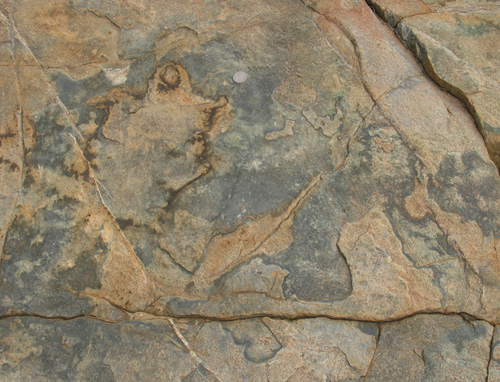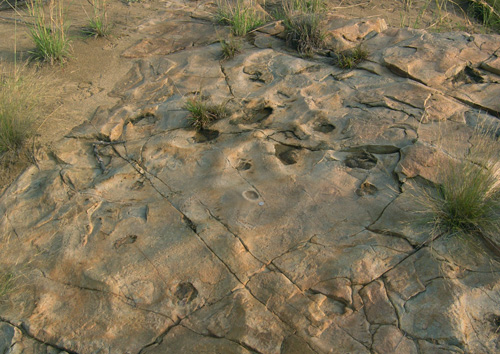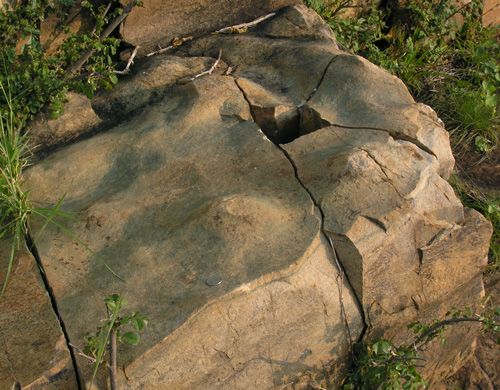Last week I ventured into the field in the company of Nora Noffke, of Old Dominion University in Norfolk, Virginia. who is an expert on the fossil record of ancient bacterial mats. It turns out that this record does not simply consist of the well-known stromatolites; in shallow marine environments mat-forming microorganisms can bind and stabilise the sediment surface, leading to the formation of distinctive structures that are not formed by purely physical processes. This is in contrast to the difficulties in distinguishing between those stromatolites that have been formed in association with bacteria, and those that have been precipitated entirely inorganically.
It turns out that the Pongola Supergroup – the Archean rocks that I am currently trying to extract a magnetic signal from – is a good place to look for these ‘microbially induced sedimentary structures’. As we’ve already seen, ripple marks, dessication cracks and other sedimentary features are extremely well preserved in the sandstones which make up the upper part of the sequence, despite their venerable age of 2.9 billion or so. Furthermore, the tidally-influenced shallow marine environment is which these rocks seem to have been deposited is prime mat-forming territory. Nora was kind enough to point out some of the outcrops that featured in her recent paper in Geobiology, which describes a section through the Pongola sandstones and makes the case that many of the preserved sedimentary features are consistent with the presence of a thriving bacterial mat ecosystem. I am not confident that I would have really noticed any of these myself: this is one of those times when knowing what you’re looking for – through a good grounding in the sort of features formed by modern mat growth in similar environments – is essential if you’re going to distinguish the real deal from modern weathering patterns on the bedding planes. Two examples are found beneath the fold.
The first picture below shows a bedding plane topped by a greenish, chlorite-rich layer which appears to have been partially eroded. What’s interesting is the manner of erosion, in that discrete planar pieces appear to have been ripped out of the green layer and transported or flipped over without being dissociated. The best example is the hole to the right of my (increasingly valueless) rand scale marker, where two boot-shaped fragments have been torn out and flipped over, but are still attached to the lower rim. This seems to show strong currents damaging and ripping apart a coherent sheet on top of the sediments, consistent with damage inflicted on bacterial mats in modern marine environments.

The second picture shows a bedding surface with a polygonal topography – the most easily spotted one is right in the centre. If you’re thinking that these look like a form of dessication cracking, produced when a wet surface dries and shrinks, then you’ll be pleased to know that that’s exactly how they’re interpreted, but with a microbial twist. The key thing to spot is the altered cavities at the centre of many of the polygons. As bacterial mats dry out and crack, they also decay, producing gases like hydrogen sulphide and methane which collect in bubbles underneath the centre of each polygon. The cavities are though to represent these gas domes, which therefore represent the remains of a dessicated bacterial mat (in some cases there is also evidence of ‘healing’ – regrowth of mat bacterial over the dessication cracks after the water rose again).

It’s always interesting to find the signs of ancient life, but the important point about finding them here is that, as I’ve mentioned several times before, the Pongola Supergroup is one of the oldest relatively unaltered cratonic cover sequences that we know about, and hence once of the earliest sequences where you can really look for these microbially influenced structures without having to worry about later deformation and alteration completely obscuring things. And if you look, there they are – evidence of a thriving bacterial ecosystem in the distant past, which are much more difficult to argue away as resulting from non-biological processes.
This makes it all the more disappointing that the section has already suffered the blight of professional geovandalism. Many of the outcrops that were described in Nora’s paper have been aggressively sampled, by people who clearly knew what they were doing, and what they were looking for:

What makes this worse is that the perpetrators apparently didn’t seem to feel that it was necessary to ask the owner of the farm that the section is found on – who was actually quite interested and excited by these discoveries – for his permission before hacking the outcrop to bits. I don’t know about you, but regardless of whether there is any scientific justification for removing these structures wholesale from their original geological context, I find such an apparently cavalier attitude profoundly embarrassing. These people should know better.



Comments (5)